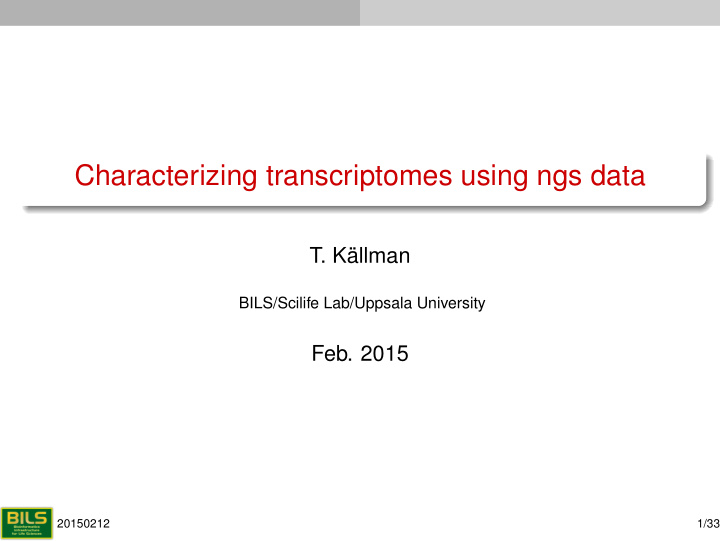



Characterizing transcriptomes using ngs data T. Källman BILS/Scilife Lab/Uppsala University Feb. 2015 20150212 1/33
Outline The transcriptome 1 RNA sequence technologies 2 RNA-seq analysis 3 Mapping based approach Tools for working with ngs alignments Gene expression from RNA-seq de-novo assembly 20150212 2/33
The transcriptome The Central Dogma DNA ATG Intron Exon Promoter Region TATA UGA Stop Codons UAA Transcription and mRNA processing UAG 5’ Un-Translated Region mRNA AAAAAAAAAAAAAAAAAAAAAAAAAAAAAAAAAAAAAAAA 3’ Poly A tail 5’ Cap Translation Protein Methionine Post-Translational Modification PO 4 PO 4 S S Active Protein 20150212 3/33
The transcriptome A more complex view 20150212 4/33
The transcriptome Transcriptomes vs genomes Dynamic, not the same over tissues and time points Smaller sequence space Less repetitive (but large gene families can be found) Fairly stable in size? ( eg. 2-4 fold change among eukaryotes, whereas genome size can vary 1000-fold) Genes are often expressed in multiple different splice-variants RNA often from only one strand 20150212 5/33
RNA sequence technologies NGS data 20150212 6/33
RNA sequence technologies Machine output 20150212 7/33
RNA sequence technologies Machine output 20150212 8/33
RNA sequence technologies Sequence quality Phred quality scores: Q = -10 x log P (High Q = high probability of the base being correct A Phred quality score of 20 to a base, means that the base is called incorrectly in 1 out of 100 times. 20150212 9/33
RNA sequence technologies Pair-end (PE) sequencing 20150212 10/33
RNA sequence technologies Pair-end reads File format Two files are created The order in files identical and naming of reads are the same with the exception of the end The way of naming reads are changing over time so the read names depend on software version @61DFRAAXX100204:1:100:10494:3070/1 AAACAACAGGGCACATTGTCACTCTTGTATTTGAAAAACACTTTCCGGCCAT + ACCCCCCCCCCCCCCCCCCCCCCCCCCCCCBC?CCCCCCCCC@@CACCCCCA @61DFRAAXX100204:1:100:10494:3070/2 ATCCAAGTTAAAACAGAGGCCTGTGACAGACTCTTGGCCCATCGTGTTGATA + _^_a^cccegcgghhgZc`ghhc^egggd^_[d]defcdfd^Z^OXWaQ^ad 20150212 11/33
RNA sequence technologies Pair-end data 20150212 12/33
RNA sequence technologies Stranded or not 20150212 13/33
RNA-seq analysis Two main routes for analysis Haas & Zody (2010), Nature Biotechnology 28, 421–423 20150212 14/33
RNA-seq analysis Mapping based approach Aligning short reads from RNA to genomes Large number of programs available: Star, Tophat, Subread etc Important feature: Allow for spliced mapping 20150212 15/33
RNA-seq analysis Mapping based approach Example workflow Tophat: Aligns reads to genome (allows for spliced read mapping) Cufflinks: Extract transcripts from spliced read alignments Cuffmerge: Merge results from multiple Cufflinks results Trapnell et al. (2012), Nature Protocols 7, 562–578 20150212 16/33
RNA-seq analysis Mapping based approach Tophat Efficient and fast alignment to the genome using bowtie2 1 Create a data base of putative splice junctions from the reads 2 mapping in step 1 Map reads that did not map in step 1 run using the splice 3 information 20150212 17/33
RNA-seq analysis Mapping based approach Cufflinks 20150212 18/33
RNA-seq analysis Tools for working with ngs alignments Samtools Program to work with ngs alignment files (SAM, BAM, CRAM) Can be used to view data, calculate basic info, extract subsets of alignments and convert between file formats http://www.htslib.org 20150212 19/33
RNA-seq analysis Tools for working with ngs alignments Picard A set of Java command line tools with the same (or similar functionality as samtools) Note that even though they largely aim at doing similar functions Picard and Samtools is not always generating compatible file formats http://broadinstitute.github.io/picard/ 20150212 20/33
RNA-seq analysis Tools for working with ngs alignments Samtools tview, a text-based alignment viewer $ samtools view alignment.bam target.fasta 20150212 21/33
RNA-seq analysis Tools for working with ngs alignments IGV: Integrative Genomics Viewer 20150212 22/33
RNA-seq analysis Tools for working with ngs alignments IGV: Integrative Genomics Viewer 20150212 23/33
RNA-seq analysis Gene expression from RNA-seq From counts to gene expression 20150212 24/33
RNA-seq analysis Gene expression from RNA-seq From counts to gene expression 20150212 25/33
RNA-seq analysis Gene expression from RNA-seq Not all reads are the same from: http://www-huber.embl.de/users/anders/HTSeq/doc/count.html 20150212 26/33
RNA-seq analysis Gene expression from RNA-seq Normalized expression Values Transcript-mapped read counts are normalized for both length of the transcript and total depth of sequencing. Count data is hence converted to: Reads/Fragments per kb of transcript length and million mapped reads (RPKM or FPKM) 20150212 27/33
RNA-seq analysis Gene expression from RNA-seq Experimental design 20150212 28/33
RNA-seq analysis Gene expression from RNA-seq Experimental design Count reads (convert to RPKM/FPKM?) Small number of reads (= low RPKM/FPKM values) often non-significant Remember that Fold change is not the same as significance Condition 1 Condition 2 Fold_Change Significant? Gene A 1 2 2-fold No Gene B 100 200 2-fold Yes 20150212 29/33
RNA-seq analysis de-novo assembly Major challenges in relation to genome assembly Genes show different levels of gene expression, hence uneven coverage among genes Many genes are expressed in different isoforms As sequence depth increase detected number of loci increase. (What is actually expressed?) Sequence error from highly expressed genes might be seen more often than "true" sequences from lowly expressed genes 20150212 30/33
RNA-seq analysis de-novo assembly Several programs available SOAP-denovo TRANS Oases Trans-ABYSS Trinity All of them uses de Bruijn graphs to cope with the data and many of them have been developed from a genome assembly program 20150212 31/33
RNA-seq analysis de-novo assembly Trinity 20150212 32/33
RNA-seq analysis de-novo assembly Trinity 20150212 33/33
Recommend
More recommend